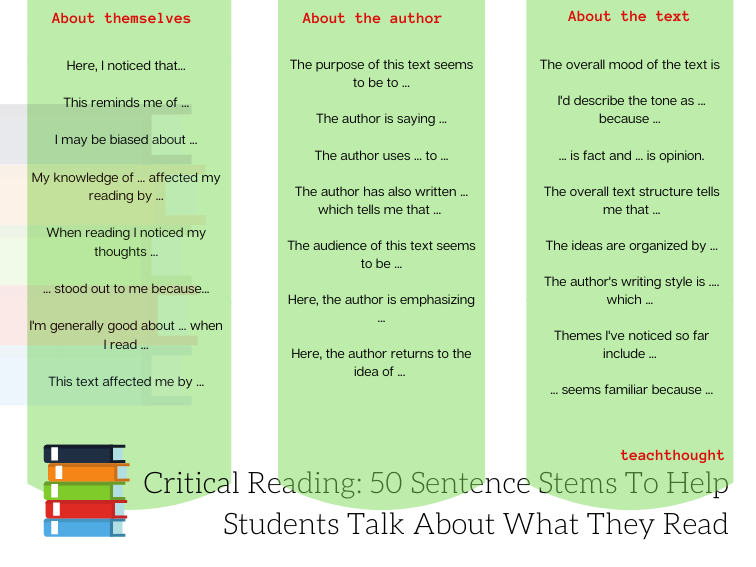
Critical Reading: 50 Sentence Stems To Help Students Talk About What They Read
by Terry Heick
I love sentence stems for many reasons, not the least of which is their ability to function as cognitive ‘training wheels’ for developing minds.
As in journal response prompts to respond to a text, the stems below are created to help students better understand what they’re reading. Because the focus is on critical thinking and critical reading rather than mere ‘talking,’ I left out more obvious stems like ‘I agree…’ or ‘I disagree…’ or ‘I like…’ or ‘I dislike…’ because–well, because opinions are useful primarily in discussing affections and preferences but less useful in critical thinking and critical reading.
That’s not to say that they don’t serve a purpose, but rather that they’re already a fairly natural reflex for even early readers who will either like or dislike or love or be bored by texts. This implies, of course, that the point of reading is recreational. While it certainly can and generally should be enjoyable, there are as many reasons to read as there are to know and do, and focusing on what you like and don’t like and agree and disagree with misses the nuance of a text.
Liking and disliking and agreeing and disagreeing, of course, matter. Emotion can be a cause and effect of understanding. But ultimately, critical reading is a matter of gathering knowledge to better understand contexts, seeing ideas from multiple perspectives, and avoiding logical fallacies and other failures of reason in order to make sense of a text.
See also The Definition Of Bloom’s Taxonomy
As for this list, I separated them into categories. Note that there’s obviously overlap between the categories (e.g., some of the stems that help students ‘talk about themselves as readers’ are similar to some of the stems that help students ‘talk about the topic’).
Stems that help students talk about themselves as readers
Here, I noticed that…
This reminds me of…
When reading I noticed that my thoughts/emotions …
While reading this, it’s helping me to … so that … (think reading strategies, etc.)
This text has changed me by …
If I … then the text could …
… stood out to me because …
My experience about or knowledge of … affected my reading by …
I might be biased about … so …
I’m generally pretty good about … when reading things like this.
See also How To Read A Book: 3 Strategies & Questions For Critical Reading
Stems that help students talk about the topic
I wasn’t aware that …
I knew that … but didn’t know that …
Recently, this (the topic) has…
The most important part about … is …
It’s important to see that …
This makes me want to read or learn more about …
This topic is important/doesn’t seem to be important in light of …
Stems that help students talk about the author & author purpose
The overall purpose of this text seems to be to …
The author has also written … which helps me understand that …
The audience of this text is likely … but could also include …
… would agree/disagree with …
The author is saying/claiming…
The author is implying…
The author seems to be trying to …
An underlying assumption of … is . …
The author is comparing … to …
The author is using … to …
The author is emphasizing …
The author is implying that …
The author seems to believe that …
Here, the author is beginning to …
It sounds like the author is saying …
Here, the author returns to the idea of …
The author seems to want the reader to notice, see, or believe that …
The author doesn’t seem to realize or know that …
See also What Are Literature Circles?
Talking About The Text
I noticed that …
The title helps me see that …
The overall mood of the text is …
I’d describe the tone of the text as … because …
… is fact and … is opinion …
Themes I’ve noticed so far include …
The front and rear covers suggest that …
The ideas are organized by … which has the effect of …
The overall structure of the text suggests …
The most important information or ideas in this text seem to be … and I know this because …
The problem with this line of reasoning or argument is …
The author’s writing style is … which …
(See also New York Times Style Guide, for one example of how some aspects of ‘style’ have formal guides while others are simply a kind of aesthetic or personal choice by the author.)
Overall, the text seems to be saying that …
There is sufficient/insufficient reasoning/evidence to support …
If the text were … then …
